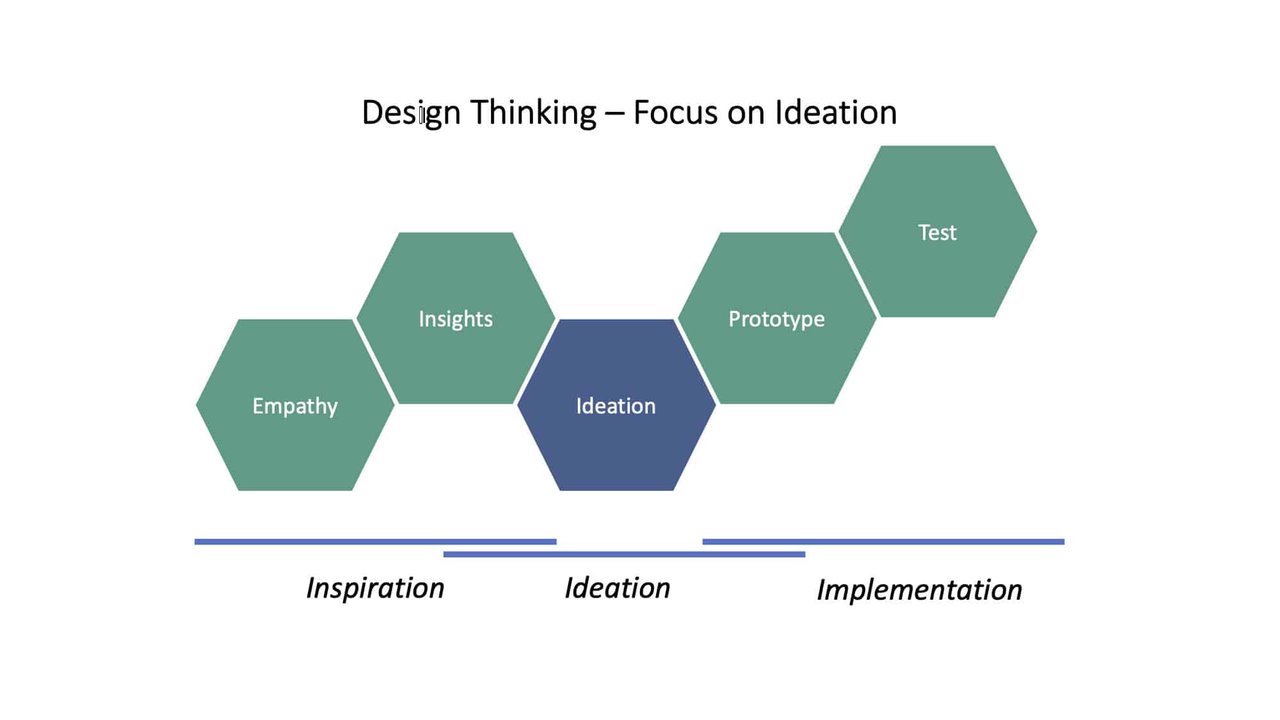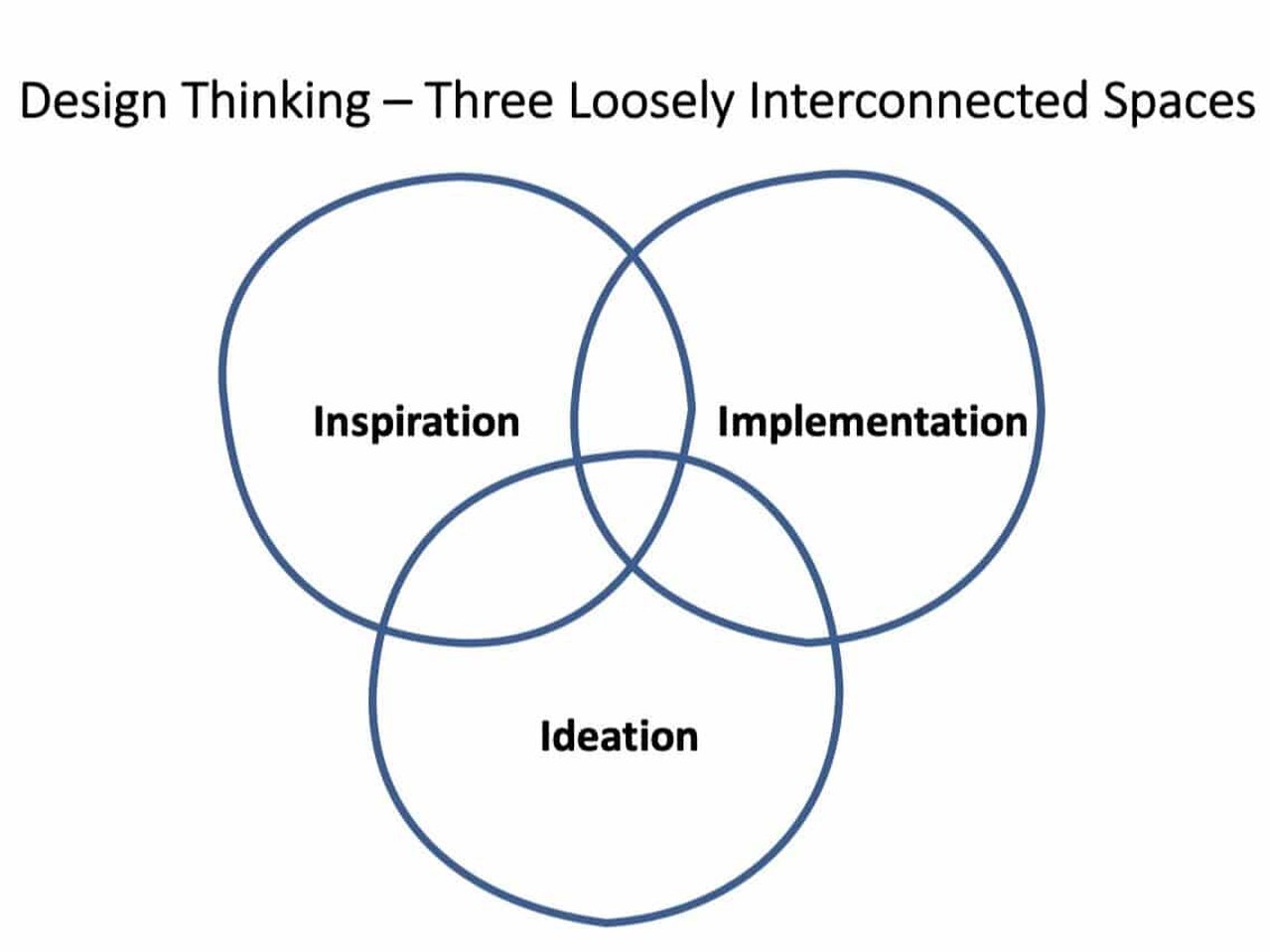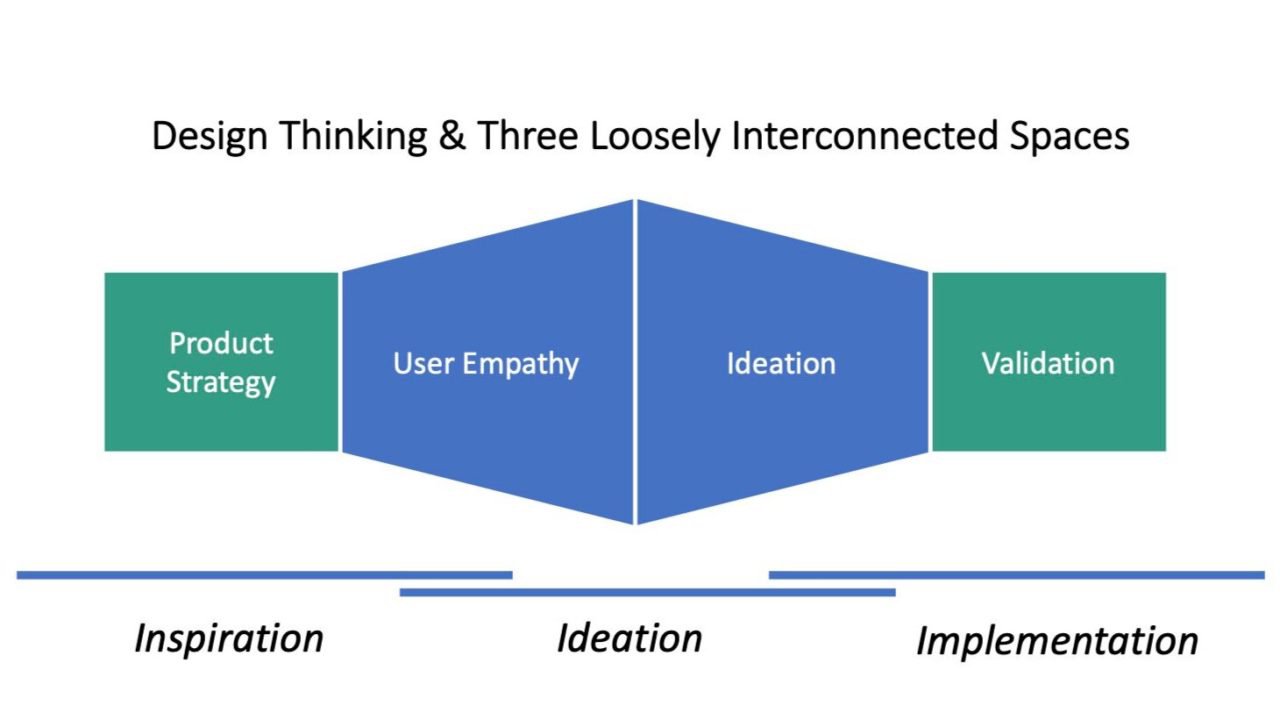Guide to Design Thinking: Design Thinking is About Product Development
What is Design Thinking and How Does it Relate to Product Development?
Design Thinking is an innovation process inspired by empathy for the user followed by ideation and implementation. While Design Thinking applies to many endeavors and many types of problems, in new product development, it is a means to direct and focus innovation that drives growth in sales and profits. It is an iterative process allowing a cross-functional design team to question its assumptions and focus on the user experience above all else.
The Design Thinking process enables teams to expand their ideas through deep insights into the problems customers face. Later in the process, Design Thinking allows teams to focus like a laser on the very best solutions. By testing prototypes with customers, and incorporating their feedback into subsequent iterations, teams separate the best ideas from the rest.

“Design Thinking is a way of looking at innovation, to find the intersection between human values, technical capability and commercial viability.”
Though in theory, Design Thinking encompasses the three overlapping circles of inspiration, implementation, and ideation, it often takes the form of a non-linear problem solving process that has anywhere between five and ten steps. There are several different models, with somewhat different steps, but practitioners need not become too rigid about the process. Design Thinking is a way of looking at innovation, to find the intersection between human values, technical capability and commercial viability.
Richard Buchanan’s paper, “Wicked Problems in Design Thinking” written in 1992 describes the roots of Design Thinking that go back to problem solving and innovation social science. Design Thinking was then popularized by the Stanford professor, David Kelley, who was the founder of the d.school there. IDEO, which brought Design Thinking into the mainstream, was founded as a merger between David Kelley Design (Kelley designed Apple’s first mouse) and another Industrial Design firm in 1991.

How does Design Thinking work in the Product Development Process?
Although Design Thinking is a system of overlapping spheres, and not a sequence of steps, it is sometimes approached in a sequential way. One way to conceive of Design Thinking is as three loosely connected spaces defined by inspiration, ideation, and implementation. Note that it works throughout the Product Development Life Cycle, too.

There are several models of Design Thinking available from such organizations as the Stanford d.School, IBM, Google, IDEO, and others. Innovators like Amazon, Apple and Google use Design Thinking concepts to clarify product discovery through customer experience insights.
Design Thinking in the context of product development usually features some version of the following steps:
- Empathizing with users: including customers, non-customers, lost customers, economic buyers, influencers, and internal customers.
- Understanding insights and user experiences: grasp their problems through deep understanding and cast them as insights.
- Ideating proposed solutions: Challenge preconceived notions and develop a range of innovative solutions.
- Prototyping proposed solutions: Begin to realize a solution.
- Testing to gain more feedback: Present prototypes to users and incorporate their feedback. For companies that market to broad markets, perform quantitative research to validate.
- Iterating and reflecting: Define concepts, prototype, and test iteratively; reflect and validate until you have produced the very best solution. Determine the MVP (Minimum Viable Product).
Do not get hung up on the perceived need to have functional prototypes. Sometimes, a product idea, represented by a paper prototype placed in front of customers is enough. The key is to get customer feedback and build it back into product definition and product design.
Characteristics of Design Thinking
- Customer empathy - walk in their shoes
- Customer Interaction at all levels in the customer journey
- Iteration by prototyping and soliciting customer feedback
- Expands the range of possible solutions by allowing for discovery
- Enables designers to focus on the best product ideas
- Innovation at the intersection between human values, technical capability, and commercial viability
What are the benefits of Design Thinking?
Practitioners of the Design Thinking process report benefits in customer satisfaction and in the fit between products and markets. Building products around the customer experience, based on observation and careful analysis of problems and requirements, reduces downstream problems and lowers support costs.
Design Thinking also has internal benefits. Since ideation is cross-functional, new product ideas have greater buy-in throughout the wider organization. The structured nature of the process decreases guesswork about new products. Decisions are made based on evidence rather than politics.
Although it has proven difficult to quantify the impact of Design Thinking, case studies abound. Most of the best cases show the effectiveness of customer insights gained through careful observation.
For example, Bank of America wanted user-centered approaches to grow the number of accounts opened. In a 2004 initiative, Bank of America engaged IDEO to better understand customer behaviors. They found that women were often the bookkeepers in the household. Many of the women researchers observed kept paper check registers with receipts and other documents stuffed inside. Looking at these registers, designers found that one woman was rounding up her purchases to the next dollar amount. In other words, if she spent $27.73 she would write $28.00 in her register. Then, at the end of the month she had a small amount left over for savings.
What is Design Thinking Good For?
- Reduces risk of product not meeting customer needs.
- Reduces dependency on individual knowledge, hunches, and opinions.
- Discovers customers’ latent needs - “wows” and delighters.
- Establishes measurable criteria for product definition.
- Encourages cross-functional ownership of new product concepts.
After exploring more than 80 product concepts, Bank of America chose a new saving account product based on their customer insight. With the bank’s “Keep The Change” program, every time a user makes a debit card purchase, the amount of the sale is rounded up to the nearest dollar amount, with the difference deposited in a savings account. The program found success with customers since it made saving money easy, painless and invisible. Savings without sacrifice.
Without seeing those handwritten check registers, designers might never have envisioned such a successful product. This example demonstrates the power of sitting down in customer spaces to observe how they use and interact with your offering.
How do you get started with Design Thinking during Product Development?
Training is essential. You do not have to do everything recommended in Design Thinking courses, but getting a good grounding in skills will get you started. The Stanford design school has excellent resources available.
It is also essential right from the beginning that leadership, usually at the General Manager or C-level, gives the design team the space to do innovation a bit differently. The Design Thinking process challenges assumptions and biases. Leadership has to give the team some space for this process, as well as the permission to operate outside of corporate norms. Senior leaders must create a protected space for Design Thinking to take root.
It is also important that teams involve the right customers from then outset. Consider not only existing customers but non-customers, prospective customers, and former customers. Also, think of internal functions or groups as customers. Include their feedback and show them demos where applicable. Many companies will need to establish relationships with customers who will have greater access to the periphery of your organization. Choosing the right customers to observe is crucial.
Is Design Thinking just for digital development?
As the Bank of America example cited above makes clear, Design Thinking applies not only to any type of product or service but to any pressing problem or need. Although Design Thinking, like Agile development, is associated with digital products, any company can modify the Design thinking process and apply it.
Beyond the digital domain, it is not always practical to have prototypes available for customer testing. Software is infinitely portable, while a complex system, for example a medical testing device, is much less so. Prototypes for complex systems might also involve dependencies, such as the input of suppliers, that make prototyping for customer feedback difficult. The time involved in creating non-digital prototypes might also inhibit companies from being able to showcase them with customers.
Nonetheless, builders of systems outside of the purely digital domain can observe and define products based on customer visits and customer insights. They can incorporate feedback from customers – including internal customers – in an iterative fashion. Getting close to customers is the essence of Design Thinking. Any company, developing any type of product or service, can create an advantage through the power of customer insights.
How do you translate user empathy into product requirements?
The most important part of the application of Design Thinking to product development is that it is a structured process for visiting customers, observing them, and deriving usable data from these visits. This is the heart of Design Thinking, empathy with customers, while observing them interacting with your product. A neglected portion of the Design Thinking process, is a methodology for converting user empathy, interview data and quantitative data into product requirements.
One method for turning customer feedback into requirements is Market-Driven Product Definition, which is a structured method, within the rubric of Design Thinking, for gathering customer input and translating them into requirements. It is a replicable process based not on guesswork, nor on a single data source such as a survey or a focus group. This focused innovation process provides a link between strategy and product requirements (or stories), based on user needs.
While methods like MDPD are useful, the essence of Design Thinking for Product Development is: 1) conducting effective customer interviews, 2) translating this feedback into requirements, and 3) generating solutions that become product specifications. In product development, the emphasis in Design Thinking is on (1) customer segmentation, (2) quantitative validation, and (3) suitability for significant new product development programs.

Design Thinking for Product Development involves:
- Gathering customer information: conduct structured customer visits.
- Developing customer requirements: analyze customer data to understand pain points and develop requirements to address them.
- Tracking metrics for requirements: create quantitative measures to define and set goals and limits to your requirements.
- Validating prioritizing and selecting requirements: test and validate the requirements with customer involvement; prioritize and select them to develop the best solution.
- Generating requirements for development: translate the validated requirements into a product specification with the best possible feature sets.
Conducting Effective Customer Interviews
The number one shortcoming of most customer interviewers is a failure to probe. Customers will talk in terms of features: “We need a 10 watt transmitter.” The interviewer needs to probe to find out why that feature is important to the customer. Uncover the problem the customer is trying to solve. Listen for the customer need.
For example, perhaps the customer’s need is to have voice communication that can be clearly received even under bridges, while working on a construction site. The need is “I want my voice to be clearly received, even under bridges.” A “10 watt transmitter” describes a product with a certain feature intended to meet the customer need.
Don’t settle for feature talk. Probe until you discover the customer’s pain. The interviewers favorite questions are “Why?” “Could you explain?” and “Could you share?” This is where your listening skills are tested.
The interviewer’s favorite questions are:
- Why?
- Could you explain?
- Could you share?
Translating Customer Feedback into Requirements
To help translate customer feedback into requirements, follow these steps:
- Identify a verb that defines the missing functionality Answer the question, “What functionality is desired but missing for the customer?” Express this functionality as a verb. For example, if the missing functionality is the ability to use a transmitter under a bridge, then the associated verb is “communicating.”
- Identify the subject Who or what performs this functionality? Be very clear about all the parties involved and what their roles are.
- Identify the modifier What is scalable or variable about the functionality? What are the limits of this variability? Define it quantitatively (E.g. “Intelligibility scores for the transmitter not less than 90%”).
- Write customer need statement Articulate the customer’s need in full sentence form. For example: “Receiving listeners must be able to understand speech clearly (Intelligibility scores of 90%) while sender is under highway overpass.”
Pro tip: Link the customer voices you hear in your visits, and all of the data that you acquire from them, to images that help define customer “delighters.” Images are descriptions that evoke a sense of being in the environment of the user. They are often rich descriptions of the context of use of the intended product or service. Images evoke emotions, which connect customers to products and are the key to exceeding their expectations.
Generating ideas that become product specifications
Generate ideas by brainstorming solutions and then validating them. Here is where design teams are challenged to question assumptions and counter confirmation bias. Expand your range of solutions beyond the obvious. Then focus on the critical few, the very best solutions.
This is also the time to investigate existing solutions available in the marketplace. The best solutions meet the requirements, and do so better than competitive offerings, while remaining within budget and market window constraints. Document the features of the solution and create a prioritized list of features.
Finally, audit the requirements. Review the requirements section of the product plan. Validate and verify how the design team gathered the requirements. Are they sufficiently detailed? Are they measurable? Do not forget to verify your assumptions, feeding back customer information to ensure optimal product/market fit.
If Design Thinking is about product development, what are some tips for being successful?
Customize Design Thinking to your business; modify steps that don’t work for you.
Don’t get stuck in rigid processes or lists of steps. Don’t get caught in the jargon. The most important aspect of the Design Thinking process is leveraging customer insights, and the process of iterative design. Gather a deep understanding from the experts, but modify the process to meet your needs.
Design Thinking requires executive sponsorship.
It does not have to be the CEO, but Design Thinking requires the support of leadership to be successful. Design Thinking is a process that thrives on questioning basic assumptions. This can be threatening to some corners of your organization, unless the process of Design Thinking is acknowledged and supported by senior leaders.
Carefully manage the cultural aspect of Design Thinking.
Design Thinking has implications for your corporate culture. For example, Design Thinking requires that the organization has permission to take risks and make mistakes. Some cultures are intolerant of anything that looks like a mistake. Be aware of where Design Thinking bumps up against the assumptions of your culture.
Don’t get stuck in your preconceived notions - use Design Thinking for problem solving.
Thinking “outside the box” is part of Design Thinking. And yet Design Thinking shows how easy it is to rely on preconceived notions. Too many design teams leap to solutions before they’ve really understood the customer’s pain. Design Thinking requires patience while teams cycle through multiple iterations of ideas and prototypes. Try it outside of product development and IT.
Learn how to listen.
Listening is a learned skill. The best listeners yield the most fruitful customer insights. It is much more common for people to have preconceived ideas in their heads that make it impossible to listen. Learn to ask “why?” five times. Ask questions and then listen carefully for the response, not just to the one that confirms your bias, but to the response that yields the richest customer experience insights.
